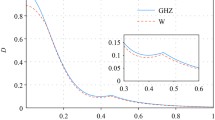Abstract
A unique wavefunction, constructed according to the original Einstein–Podolski–Rosen (EPR) description, is used here to analyze the behavior of two equal non-interacting quantum systems: S(1) and S(2).The results show that the EPR paradox, which will be referred as EPR effect in this work, always appears in this theoretical context. When the expectation value of a Hermitian operator is sought, it can yield two different values, when measured on S(1) or S(2). However, the EPR effect disappears if the wavefunction is chosen symmetric or antisymmetric by interchanging the S(1) and S(2) coordinates. The same EPR effect appears when the expectation value of a state selector projection operator is computed on S(1) or S(2), but it disappears within a symmetric or antisymmetric EPR wavefunction form. On the other hand, the action of the selectors over the EPR wavefunction provide images on EPR system S(1) or S(2) which could be different, so the EPR effect persists except if, similarly as in the statistical case, a wavefunction constructed with a symmetric or antisymmetric superposition with respect the EPR system coordinates is used. Thus, with appropriate wavefunction choices, in statistical expectation value measures and non-statistical selector images as well, the EPR effect could not persist.
Similar content being viewed by others
References
R. Carbó-Dorca, On Einstein–Podolski–Rosen (EPR) paradox, J. math. Chem. (in press)
Einstein A., Podolsky B., Rosen N. (1935). aaaaaa. Phys. Rev. 47: 777
See, for example: R. Carbó-Dorca, J. Mol. Struct. Teochem. 537 (2001) 41–54
Messiah A. (1999). Quantum Mechanics. (Dover Publications Inc., New York
Bohm D. Quantum Theory. Dover Publications Inc., New York
Carbó-Dorca R. (1998). Advances in Molecular Similarity, Vol. 2. JAI Press, London, pp. 43–72
Carbó-Dorca R. (2002). aaaaaa. J. Math. Chem. 32: 201–223
See, for example: I. M. Vinogradov (ed.), Encyclopaedia of Mathematics (Reidel-Kluwer Academic, Dordrecht, 1989)
Author information
Authors and Affiliations
Corresponding author
Additional information
*This second paper on EPR paradox is also expressly dedicated to the memory Professor Einstein, in order to celebrate the 100th anniversary of the first paper on relativity theory, but also to commemorate the 75 anniversary of the publication of EPR paradox, thus, as before, Professors Podolski and Rosen are also included in the homage.
Rights and permissions
About this article
Cite this article
Carbó-Dorca, R. A Discussion on the Einstein–Podolski–Rosen (EPR) Effect* in a Unique Wavefunction Quantum Mechanical Framework. J Math Chem 39, 267–279 (2006). https://doi.org/10.1007/s10910-005-9031-3
Received:
Revised:
Published:
Issue Date:
DOI: https://doi.org/10.1007/s10910-005-9031-3




